Managing Editor, Features and Multimedia
How Drivers and Autonomous Trucks Could Work Together to Move Freight
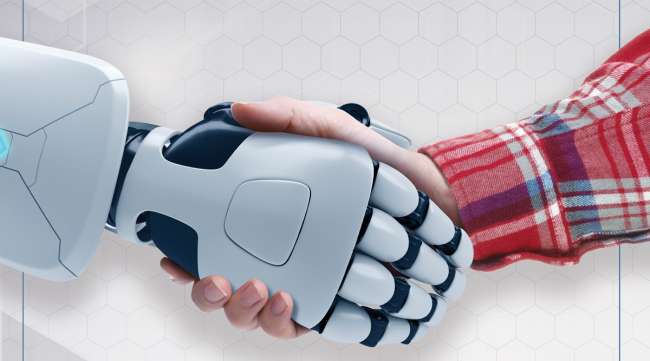
The advent of automated driving technology is poised to transform the trucking industry in the years and decades to come, but it is clear that autonomous trucks will not be ready to handle all driving tasks and conditions anytime soon.
Instead, the developers of this technology are working to build a future where drivers and automation work hand in hand to transport freight more safely and efficiently.
Exactly how that combination of human labor and automated systems will take shape remains an open question, but a number of competing concepts have been proposed.
Several technology firms and startups hope to introduce fully autonomous trucks in the near future by limiting the scope of where they can operate, leaving much of the work to drivers in conventional vehicles.
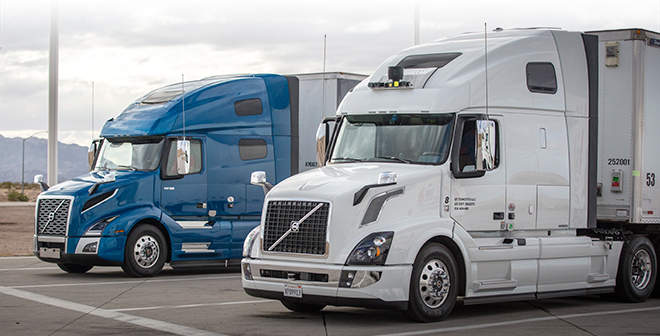
Some autonomous truck developers, including Uber's Advanced Technologies Group, envision unmanned longhaul trucks stopping at transfer stations to exchange trailers with conventional trucks piloted by local and regional drivers. (Uber Advanced Technologies Group)
Under the “transfer hub” model, for example, unmanned longhaul trucks would travel from exit to exit on freeways and swap trailers with trucks operated by local drivers at designated transfer stations.

In our debut episode of RoadSigns, we ask: What does the move toward autonomy mean for the truck driver? Hear a snippet from Alex Rodrigues, CEO of Embark, above, and get the full program by going to RoadSigns.TTNews.com.
Other concepts include “teleoperation” of autonomous trucks with remote backup drivers, or piggybacking on truck platooning technology to create mixed convoys of piloted and autonomous vehicles.
These business models could begin to address trucking’s persistent labor shortage and high driver turnover rates, but they also may require fleets to make changes to the structure of their operations. And developers would need to demonstrate a clear return on investment for fleets to adopt the technology.
As companies pursue these various methods of deploying autonomous trucks, they are concentrating first on specific freight moves rather than attempting to automate all types of driving.
“The common theme, when you look at all these business models, is that these are limited applications,” said Mike Cammisa, vice president of safety policy, connectivity and technology at American Trucking Associations.
“They lend themselves to certain types of freight movement, but not all,” he said. “That’s why we still see that need for truck drivers. You still need the driver to handle certain elements of the driving task.”

Google sister company Waymo, best known for its self-driving passenger cars, also is using its technology to operate heavy-duty trucks in the Atlanta area. (Waymo)
A growing list of companies are developing automated driving systems for commercial trucks, including Alphabet Inc.’s Waymo division, formerly the Google self-driving car project. Waymo is now operating self-driving trucks in the Atlanta area, hauling server equipment and other materials to data centers operated by sister company Google.
Other players in the nascent self-driving truck industry include ride-hailing firm Uber Technologies Inc., as well as tech startups such as Embark, TuSimple and Starsky Robotics.
These firms have been testing on highways, but for now their trucks still have “safety drivers” behind the wheel as a backup.
Meanwhile, truck manufacturers and braking system suppliers also are exploring the potential of self-driving trucks, but in general, they are pursuing a more gradual pathway to automation.
For these companies, the baseline for development is to build upon today’s active-safety technology by adding automated steering functionality and more advanced software and sensors that further support the driver.
Over time, these advanced driver-assist technologies could eventually morph into highway “autopilot” systems, which may or may not rely on a human operator in the truck as a fallback.
In the near term, private or restricted sites could provide early opportunities for the deployment of unmanned vehicles, which already are being used in the mining and agriculture industries in some countries.
As automated driving technology advances, trucking companies are beginning to examine these possibilities.
Bob Verret, chief information officer for Dupré Logistics, said the industry likely will move toward “hybrid” business models that incorporate both drivers and automation.
“There’s going to have to be some marriage of the technology with the driver that maybe makes the job a little more pleasant for some people,” he said. “It’s a tough job to be a driver, and some of these technologies are making it just a little bit easier to do it.”
Verret predicted that truly autonomous trucks would be restricted to large freeways and would perhaps drop trailers at depot stations for drivers of conventional trucks to pick up.
“It will help to ease the driver shortage, but we’re never going to eliminate the driver’s job as I see it today, at least not in my lifetime,” he said.
Some level of human labor may always be required for many tasks in the trucking industry.
One example is the delivery of gasoline, a core service provided by Dupré Logistics.
“I don’t know how you get an autonomous vehicle to take a hose off the truck at the pump and connect it to a tank on the ground,” Verret said. “It just isn’t going to happen.”

Rodrigues
Even the technology developers that are working to enable fully autonomous trucks still see a definite need for drivers for many years to come.
“This is something that is going to happen at a methodical cadence, not an instant rush,” said Alex Rodrigues, CEO of self-driving truck startup Embark.
The company aims to refine its technology to the point where autonomous trucks can operate on freeways with no one onboard as part of a transfer-hub arrangement.
Even so, Rodrigues said he believes that younger truck drivers won’t have a hard time finding work later in their careers given the existing driver shortage, the large number of workers retiring from the profession and the fact that many trucking applications are not well-suited to automation.
At the same time, automation could improve trucking efficiency, which would reduce transportation costs, therefore lowering the cost of goods and driving an increase in demand that will lead to more freight.
“Until we get through the entire driver shortage, plus the increase to demand, which is probably hundreds of thousands of trucks, we’re actually going to be increasing the number of local drivers without an adverse effect on longhaul drivers,” Rodrigues said.
Bart De Muynck, supply-chain research director at Gartner Inc., agreed that autonomous trucks will not replace drivers, but augment existing freight-hauling capacity while helping truckers improve productivity or convert longhaul jobs into more desirable shorthaul jobs.
Even when the technology is ready, adoption will likely move at a gradual pace, he said, because it will take time for the government to establish a regulatory framework, and for truck makers to manufacture vehicles equipped for autonomous operation.
“It will take a while before we see even a very small percentage of these vehicles appearing on the road,” De Muynck said.
TuSimple, another self-driving truck developer, plans to support fleet customers who want to deploy unmanned trucks, as well as those who prefer to keep a driver in the cab.
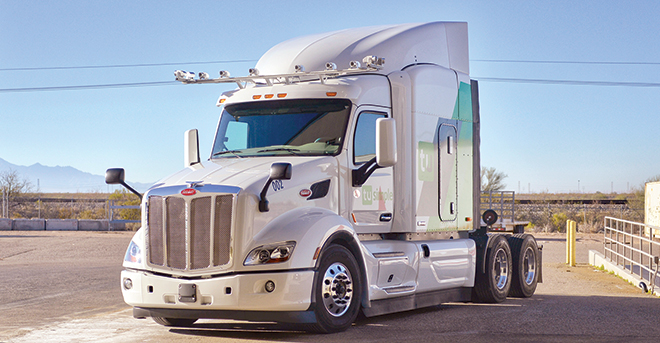
Technology startup TuSimple is testing self-driving trucks in both the United States and China. (TuSimple)
“We know there will be situations where there will be a driver on board, whether they’re driving or not,” said Chuck Price, vice president of product at TuSimple. “We think that when you have a driver in the seat with the autonomous system running, you’ve got a copilot that never falls asleep. And that’s an awesome combination.”
The company, dually headquartered in Beijing and San Diego, is testing its technology in Arizona, between Tucson and Phoenix, and plans to begin moving freight for shippers in the third quarter.
Price said TuSimple will establish and operate its own fleet of self-driving trucks with its own drivers to prove the technology before offering it to trucking companies.
In contrast to some of its competitors, TuSimple has committed to develop autonomous trucks that travel not between transfer hubs, but from dock to dock, including service streets into distribution centers.
Removing the driver altogether could reduce costs by about 40% through labor savings, but an autonomous truck with a driver on board could still provide a return on investment through improved fuel economy, Price said. If the self-driving truck can convert the rest time currently required by driver hours-of-service regulations into slower highway speeds, it can reduce fuel consumption by about 15%, he said. “Both of those are big numbers on their own.”
However, any savings based on modifications to hours-of-service requirements for automated driving systems will be dependent on regulatory changes.
That’s a topic that ATA described as an important consideration — and an area for future research — in recent comments submitted to the Federal Motor Carrier Safety Administration.
Any regulatory changes presumably would reflect the level of automation. A system where the driver still needs to monitor the vehicle’s progress, for example, would likely be treated differently from a system where the driver can climb into the sleeper berth.
“Those will be two very different things if you’re trying to change hours of service to recognize the capabilities of the technology,” ATA’s Cammisa said. “So it’s a little bit early, but there should be some recognition that that’s a possibility.”
Five Business Models for Deploying Self-Driving Trucks

Even as technology companies forge ahead with autonomous-truck testing, truck manufacturers and suppliers continue to pursue a more gradual pathway toward higher levels of automation based on the further development of advanced driver-assist systems, or ADAS.
Rather than attempting to fully automate driving right away, this approach builds upon today’s active-safety technology by adding more functions that support rather than replace the driver.
The latest safety systems for commercial trucks already provide collision mitigation, adaptive cruise control and lane-departure warnings. In the years ahead, automated steering functions also will become available.
The broad applicability of ADAS means that this approach will likely serve as the baseline for the development of automated trucking, at least in the near term. While early autonomous trucks will be limited to specific freight corridors or operations, ADAS could be applied to virtually any on-road application without requiring any changes to fleets’ existing business models.
Over time, the evolution of ADAS could potentially give rise to highway autopilot systems that may allow the driver to relinquish control of the vehicle.
“All of the ADAS systems today are walking us that little bit closer to semi-autonomous or fully autonomous operation,” said Darren Gosbee, vice president of powertrain and advanced technologies at Navistar Inc., which builds International brand trucks.
Today’s active safety technology already provides longitudinal control through adaptive cruise control and collision mitigation. The next step will be to add lateral control with automated steering, beginning with lane-keeping assist to help move the vehicle back in its lane if it strays over the line.
From there, manufacturers could introduce active lane management to keep the truck centered in its lane.
“The lateral control is where things start to become a lot more interesting,” Gosbee said.
Suppliers such as Bendix Commercial Vehicle Systems, Bosch, Wabco and ZF Group all are working to provide automated steering controls for the next wave of automated driving systems.
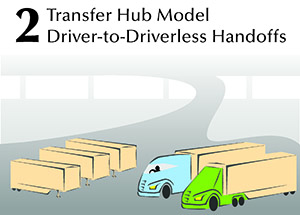
The transfer-hub model has emerged as one of the leading concepts for deploying fully autonomous trucks in the near future.
This model is designed to accelerate the introduction of unmanned trucks by limiting them to major freeways, where driving is easier to automate than on roads with intersections and cross traffic.
These autonomous trucks would haul freight across long distances from exit to exit on interstate routes, while drivers would continue to handle the more complex driving tasks associated with the moves from origin to the interstate and from the interstate to the final destination.
To make this model work, conventional trucks piloted by drivers would exchange trailers with the autonomous trucks at designated transfer stations situated near the interstate.
In addition to automating the longhaul portion of the shipment, the transfer-hub model also would shift the truck driving profession toward more desirable regional and shorthaul jobs that provide more home time.
To work on a large scale, however, the transfer-hub model would require the establishment of new drop yards near interstates where these trailer exchanges could take place. This infrastructure could be built through public funding, but the private sector may need to make the initial investments to prove the concept first.
Self-driving truck developers Uber and Embark both have championed the transfer-hub approach as the best way to introduce fully autonomous trucks in the near term.
These technology companies have been testing self-driving trucks on public highways, but today their trucks travel with backup “safety drivers” on board to intervene if necessary.
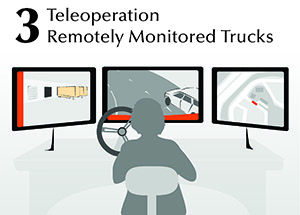
Some self-driving truck startups have turned to teleoperations to work around the limitations of automated driving technology.
These companies are developing vehicles that drive themselves, but are monitored from afar by remote drivers sitting in an office.
These remote drivers oversee the progress of the fleet’s trucks from their desks and can provide support when necessary.
If it’s necessary for the truck to change lanes, for example, the remote driver can view video from onboard cameras to ensure that it is safe to do so. Once the remote driver makes that decision, the self-driving truck then executes the lane change itself.
In certain low-speed environments, such as a truck terminal or loading dock, remote drivers might take direct control of the vehicle from afar with steering wheels at their desks.
Starsky Robotics is one company implementing a version of this teleoperations concept. In February, the company conducted a series of short test runs where one of its heavy-duty trucks drove itself with no one onboard the vehicle on a closed-off section of a public road in Hendry County, Fla.
By moving drivers out of the cab and into offices, the company believes it can help solve the trucking industry’s driver recruiting challenge.
Sweden-based Einride also is using teleoperations to combine the capabilities of autonomous driving systems with human decision-makers.
“The teleoperations part really allows us to get to market much quicker than if you wait for Level 5 [full autonomy] in all situations,” CEO Robert Falck said.
At first, Einride will have a dedicated remote driver for each unmanned vehicle, but over time, the company plans to expand the remote driver’s responsibility to overseeing up to 10 vehicles at a time, Falck said.
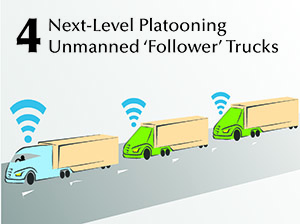
The emergence of truck platooning technology also could provide a pathway toward higher levels of automation.
Platooning technology enables two or more trucks to travel in a tight, aerodynamic convoy by synchronizing their braking and adaptive cruise control through dedicated short-range communications.
Commercial platooning is expected to become available soon.
Peloton Technology is aiming to launch its two-truck platooning system late this year. By traveling in these platoons, the lead truck can save about 4.5% on fuel consumption, while the rear truck can save about 10%, the company said.
While automated driving capabilities could eventually be added to platooning, Peloton’s launch system will still have a driver in both vehicles, and both drivers will continue to steer. Only braking and acceleration will be automated while the platoon is active.
Daimler Trucks North America, which manufactures Freightliner and Western Star trucks, also has announced plans to introduce a platooning system of its own. In contrast to Peloton, DTNA has stated that its system will come with automated steering capability to help support the driver of the follower truck in the platoon.
Over time, as platooning technology advances, some industry analysts have suggested that it could serve as a foundation for the deployment of highly automated trucks.
In theory, driverless trucks could hit the road as part of a truck platoon led by a manned truck. In this scenario, a single driver would operate the lead truck while one or more unmanned trucks automatically follow. This model would enable a single driver to “drive” two or three trucks at once.
Technology expert Larry Burns, a former corporate vice president of research and development at General Motors, pointed to follower trucks in platoons as an early use case for driverless trucks during a presentation in October at American Trucking Associations’ Management Conference & Exhibition.
Unmanned follower trucks in platoons could help pave the way for stand-alone autonomous trucks to begin operating on highways, Burns said.
Industry analyst Richard Bishop of Bishop Consulting also said the idea of a driverless follower truck in a platoon has gained some traction.
“That idea has taken root,” he said. “It’s a natural evolution, so I can see that in the future.”
Before the industry would consider unmanned trucks in platoons, the first generation of platooning technology — with drivers in both trucks — will need to prove itself in real-world operations, Bishop said.

Private or restricted sites represent perhaps the least challenging environment for unmanned trucks.
To some extent, it’s already here.
Today, large unmanned vehicles are operating in mines on private sites in Australia, for example. These vehicles drive themselves from point A to point B on private roads, but there are no pedestrians, cyclists or cars to avoid, which makes the technology easier to deploy.
Agriculture is another industry where self-driving trucks are already in use. Volvo Trucks, for one, has introduced a self-steering truck in Brazil for the harvesting of sugar cane. In this case, the truck still has a driver, but the automated steering system precisely follows a particular grid to avoid driving over crops and increase the yield.
Volvo also has introduced a fully autonomous truck for mining operations in Sweden.
“On the off-road side, there’s been more adoption and more maturity, because in off-road you don’t have the regulations,” said Bart De Muynck, an industry analyst at Gartner Inc.
Logistics yards and ports also have been identified as potential environments for unmanned vehicles.
But both have their challenges.
“The tricky thing about yard automation is the hook-ups to trailers and the things that humans do now other than driving,” Richard Bishop of Bishop Consulting said. “That’s got to be solved for that to launch, and it’s not easy.”
Port drayage, which often involves very short truck runs that lend themselves to automation, is another potential opportunity for deployment. But regulation would become a factor for trucks hauling containers on public roads from the port to a distribution center.
As part of their testing, some self-driving truck developers are beginning to put the transfer-hub model into practice.
Uber’s Advanced Technologies Group has used the port of entry in Topock, Ariz., at the border with California as a drop yard for trailer handoffs between conventional and automated trucks.
Uber’s automated trucks had been hauling shipments across Interstate 40 in Arizona, but the company ended its autonomous vehicle operations in the state after one of its self-driving passenger cars struck and killed a pedestrian in March. The crash is under investigation by the National Transportation Safety Board. Uber said it remains committed to self-driving technology and intends to resume testing elsewhere in the near future.
Embark also is pursuing the transfer-hub approach as a way to balance the capabilities of automated driving systems with finding an ideal arrangement for drivers.
“On the one hand, we want to work within the constraints of the technology, and what’s reasonable to get a computer to do,” Rodrigues said. “On the other hand, we want to work within the constraints of the driver pool. We understand that drivers are going to be a key piece of ‘driverless’ for a long time.”
While autonomous trucks will be able to drive themselves on long straightaways, the day when they will be able to operate themselves in cities is “very far away,” he said.
Given that limitation, one approach would be to keep the driver in the truck and simply pass control back and forth depending on the driving environment.
But Rodrigues said that model wouldn’t work for drivers, who are already difficult to recruit.
“You’re sleeping in a moving truck, which is even worse than stopping on the side of the road and finding a motel or sleeping in the bunk,” he said. “For 24 hours a day, you’re trapped in a moving truck, and you’re getting called upon at random, so you’re still kind of on all the time.”
In contrast, the transfer-hub model makes the job more appealing by converting longhaul trucking jobs into shorthaul jobs where drivers can sleep in their own beds, while the longhaul truck operates without a driver.
“The drivers want to be driving continuously for a big block of time, they want to get paid, and then they want to be off, ideally in their own town,” Rodrigues said.
On the other side of the Atlantic, Swedish startup Einride plans to use remote drivers to deploy a different type of autonomous vehicle.
Rather than outfitting traditional trucks with self-driving equipment, Einride is using unmanned cargo vehicles with no cab, pedals or steering wheel. These electric powered “T-pods” can carry up to 15 standard European pallets, are about 23 feet long and weigh 33,000 pounds at full capacity.
Einride recently announced plans to deploy the first T-pod in the third quarter through a partnership with transportation firm DB Schenker. The vehicle will travel between two DB Schenker warehouses in Jönköping, Sweden. A portion of the route is on a public road, Einride said.
“Electric and autonomous trucks are two key future technologies that will disrupt the global transport and logistics market. We are happy that we can test a combination of these two future technologies in cooperation with Einride at such an early stage,” said Ewald Kaiser, chief operating officer at DB Schenker.
Einride also has plans to begin a separate deployment of T-pods in southern Sweden later this year through a partnership with supermarket chain Lidl.
Meanwhile, the introduction of automated steering promises to take driver-assist technologies to the next level.
At the North American Commercial Vehicle Show in September, Wabco previewed its OnLane Assist product, a lane-keeping assist feature that will use automatic steering correction to nudge the truck back in its lane.
“We think that’s the very logical and very effective next step,” said Jon Morrison, president of Wabco’s Americas business unit.
Wabco aims to make OnLane Assist available in the first half of 2019, he said.
Industry newcomer Tesla Inc. also is developing driver-assist technology.
When the manufacturer introduced its all-electric Tesla Semi in November, co-founder and CEO Elon Musk announced the truck would come standard with “Enhanced Autopilot,” which will include automatic emergency braking, automatic lane keeping and lane-departure warnings.
Musk said Tesla intends to begin production of the truck in 2019.
Wabco’s Morrison also highlighted the potential of vehicle-to-vehicle communications to support the move to automation.
While most of today’s development work is proceeding without the use of V2V, Morrison said connectivity will be important, longer term, for wide-scale deployment of autonomous vehicles.
“I think it will be important for each vehicle to understand where it is in relation to other vehicles,” he said.
The Paths to Autonomous Trucking
As the trucking industry explores deployment concepts such as advanced driver-assist systems, transfer hubs, teleoperations, platooning and off-road automation, it’s not clear that there will be only one winner among these various approaches.
In fact, these emerging business models could be “additive,” said analyst Richard Bishop, president of Bishop Consulting.
For example, autonomous trucks operating as part of a transfer-hub model also could platoon on the highway, while private-site automation could help solve some of the last-mile challenges.
“They fit together like puzzle pieces,” Bishop said.
Regardless of which business models take hold, it’s clear that the truck driver will remain an indispensable part of the transportation industry for decades to come, and perhaps indefinitely.
Even the most aggressive visions for automation in trucking still rely on humans to pilot trucks for local hauls and last-mile deliveries, or perhaps as remote operators, for many years to come.
The job of the truck driver, however, may evolve into more of a systems manager than an equipment operator. And traditional driving jobs could shift toward local and regional routes that afford greater home time and are less prone to driver turnover while automated trucks begin to pick up a greater portion of longhaul shipments.
Volvo Trucks said it sees self-driving trucks becoming a reality in North America at some point in the future, probably starting in confined or private areas under controlled conditions.
While the move toward fully automated vehicles represents part of the development, Volvo said it is focusing on a “stepwise approach” through implementing advanced driver-assistance technology to support the driver.
“Automation is not about eliminating jobs,” said Ann-Sofi Karlsson, Volvo Trucks’ global director of human factors for automation. “Skilled professional drivers will still be in high demand. As trade and the world population continues to grow, so does the transport of goods. Automation is about making it more efficient.”
Daimler Trucks North America, which manufactures Freightliner and Western Star trucks, sees today’s active-safety and driver-assist systems as the building blocks for automated vehicle technology.
Researching and testing highly automated vehicles will accelerate the evolution of technologies that can save lives, while also potentially improving driver utilization, productivity, efficiency and ultimately drivers’ quality of life, said Derek Rotz, DTNA’s director of advanced engineering.
“DTNA believes the driver will continue to remain an integral part of highly automated vehicles as humans are essential to ensuring the safe operation of these systems,” he added.

Andersky
To succeed in trucking, automated driving systems will need to provide fleets with a return on investment, said Fred Andersky, who heads the controls business and industry affairs at Bendix Commercial Vehicle Systems, a supplier of braking and safety technology.
About 15 years ago, Bendix offered a system called XVision that used onboard cameras to provide the driver with infrared night vision.
“It was really cool,” but the problem at the time was the cost, which was too high for most fleets to consider, Andersky said.
Modern automated driving systems could face the same issue. As technology companies push to make autonomous trucks a reality, part of their challenge will be getting there cost effectively, particularly if they incorporate expensive, high-tech sensors such as lidar in their designs.
“Even if you’re getting productivity gains, if you’re not really fully eliminating the driver, it’s going to take longer to get that return on investment,” Andersky said.
If these onboard sensors are adopted broadly in the automotive sector, however, costs could decrease through economies of scale.
Before fully autonomous trucks take to the road, the motoring public also will need to become more comfortable with the idea, Andersky added.
“The fear factor is going to be pretty high, unless, of course, truly autonomous cars or light vehicles really do make a mark and shift that perception for people,” he said.
Another factor of great importance for autonomous trucking will be federal regulators’ position on unmanned vehicles, said Bishop of Bishop Consulting.
“If they move as slowly as the federal government usually moves, I’m very curious if driverless will ramp up first in China, for instance, or Australia,” he said. “These startup companies have to deploy somewhere. They can’t wait forever.”
The Future of Truck Design
If and when fully autonomous trucks enter the industry in significant numbers, this technology eventually could enable manufacturers to reconsider truck design.
There will be questions about where to place all of the sensors for self-driving, but beyond that, the first autonomous trucks generally will look much the same as today’s trucks.
“On initial vehicles, function will take priority over form,” said Darren Gosbee, vice president of powertrain and advanced technologies at Navistar.
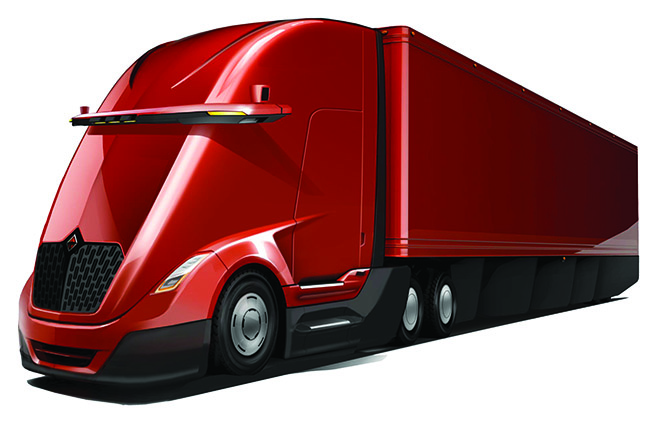
A Navistar rendering of what a fully autonomous truck might look like someday (Navistar Inc.)
But at some point in the future, as autonomous-truck deployments expand, there could be opportunities to remove the sleeper berth and even the cab altogether.
However, autonomous tractors for on-highway operation still will need to maximize aerodynamics for fuel efficiency, Gosbee said. That means future cabless trucks may still have a wedge-like shape to streamline a box trailer.
During the early deployment phase, autonomous truck volumes won’t be high enough to justify a redesign, Embark’s Rodrigues said. “It’s much faster to use what we have today and change it as little as necessary until you have real volume on the road.”
Even when autonomous trucks do become commonplace on highways, it still could be a very long time before manufacturers remove the cab completely, Rodrigues predicted.
That’s because there will continue to be situations where fleets will need to drive the vehicle manually, such as when technicians move the truck while it’s in the shop for maintenance.
“You’re going to want the vehicle to be drivable,” Rodrigues said.
What may happen, however, is a move toward a “stripped down” cab without the latest and greatest driver-comfort features since the vehicle will only rarely be driven, he added.
PeopleNet, a supplier of connected-vehicle technology, also is keeping an eye on the emergence of autonomous trucks.

A driver controls a truck remotely during an experiment conducted last year by PeopleNet. (Sigma Integrale)
The company conducted an experiment last year with a self-driving truck operated by a remote driver sitting in a “pod” designed to simulate a truck cab.
This remote driver used a steering wheel and pedals in the pod to maneuver the vehicle in a closed-off, private parking lot, said Mark Botticelli, PeopleNet’s chief technology officer.
For this experiment, the company used three different cellular connections to transmit data, including video feeds from onboard cameras, between the truck and the remote driver.
For this remote-pilot concept to work in real-world operations, however, developers would need 5G networks to come online so the remote driving system can transmit the necessary data with very little latency, Botticelli said.
When that day arrives, PeopleNet could provide the connected-vehicle services that would support remote driving, he said.
“Although PeopleNet will never build an autonomous vehicle, we’re experimenting with them because we know it will be a reality and we want to be prepared for it,” Botticelli said.

